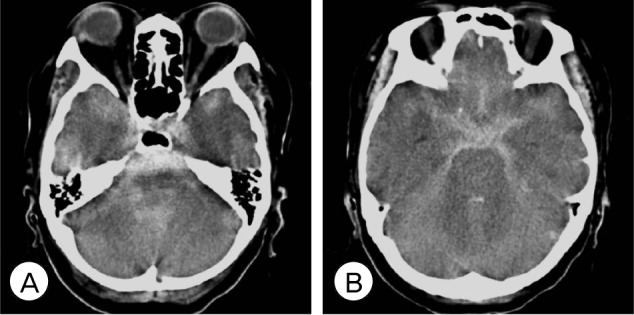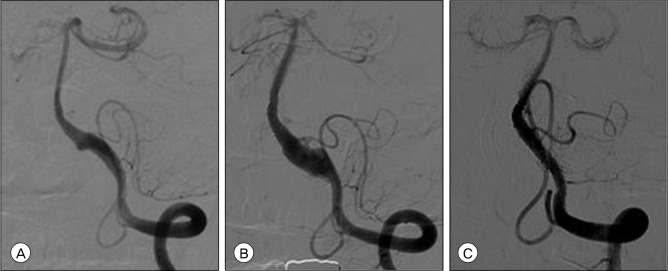J Cerebrovasc Endovasc Neurosurg.
2013 Sep;15(3):229-234. 10.7461/jcen.2013.15.3.229.
The Difference of Each Angiographic Finding After Multiple Stent According to Stent Type in Bilateral Vertebral Artery Dissection
- Affiliations
-
- 1Department of Neurosurgery, Bucheon St. Mary's Hospital, The Catholic University of Korea, Bucheon, Korea. armada1997@naver.com
- 2Department of Neurosurgery, St. Paul's Hospital, The Catholic University of Korea, Seoul, Korea.
- KMID: 1491444
- DOI: http://doi.org/10.7461/jcen.2013.15.3.229
Abstract
- We report a case of spontaneous bilateral intracranial vertebral artery dissecting aneurysms with subarachnoid hemorrhage. One dissecting lesion was treated with a coronary balloon-mounted stent (BMS) technique; however, due to differences in access route tortuosity, the other lesion was treated with a self-expandable stent (SES) technique. After 2 months, the angiographic outcome showed complete healing of the dissected segment on the side that was treated with BMS; in contrast, the dissection lesion appeared to be re-growing on the side that was treated with SES. Complete treatment of the aggravated lesion was achieved by additional deployment of BMSs. Therefore, we have provided a discussion of the possible reasons for this difference in outcome according to the stent type.
Keyword
MeSH Terms
Figure
Reference
-
1. Bendok BR, Przybylo JH, Parkinson R, Hu Y, Awad IA, Batjer HH. Neuroendovascular interventions for intracranial posterior circulation disease via the transradial approach: Technical case report. Neurosurgery. 2005; 3. 56(3):E626. discussion E626. PMID: 15730593.
Article2. Horton TG, Kalapos P, Cockroft KM. Brachial artery approach for endovascular treatment of posterior circulation intracranial vascular disease: Technique and application in 5 cases. J Stroke Cerebrovasc Dis. 2012; 1. 21(1):68–74. PMID: 20851626.
Article3. Inoue A, Kohno K, Takechi A, Kohno K, Matsushige T, Takeda T. Bilateral vertebral artery dissecting aneurysm with subarachnoid hemorrhage treated with staged bilateral vertebral artery coil occlusion: A case report. Surg Neurol. 2008; 9. 70(3):319–322. discussion 322. PMID: 18207505.
Article4. Katsuno M, Mizunari T, Kobayashi S, Takahashi H, Teramoto A. Rupture of a vertebral artery dissecting aneurysm developing immediately after trapping of a dissecting aneurysm on the contralateral vertebral artery: Case report. Neurol Med Chir (Tokyo). 2009; 10. 49(10):468–470. PMID: 19855144.5. Kim BM, Shin YS, Kim SH, Suh SH, Ihn YK, Kim DI, et al. Incidence and risk factors of recurrence after endovascular treatment of intracranial vertebrobasilar dissecting aneurysms. Stroke. 2011; 9. 42(9):2425–2430. PMID: 21778439.
Article6. Kim M, Levy EI, Meng H, Hopkins LN. Quantification of hemodynamic changes induced by virtual placement of multiple stents across a wide-necked basilar trunk aneurysm. Neurosurgery. 2007; 12. 61(6):1305–1312. discussion 1312-3. PMID: 18162911.7. Kim M, Taulbee DB, Tremmel M, Meng H. Comparison of two stents in modifying cerebral aneurysm hemodynamics. Ann Biomed Eng. 2008; 5. 36(5):726–741. PMID: 18264766.
Article8. MacKay CI, Han PP, Albuquerque FC, McDougall CG. Recurrence of a vertebral artery dissecting pseudoaneurysm after successful stent-supported coil embolization: Case report. Neurosurgery. 2003; 9. 53(3):754–759. discussion 760-1. PMID: 12943592.
Article9. Meng H, Wang Z, Kim M, Ecker RD, Hopkins LN. Saccular aneurysms on straight and curved vessels are subject to different hemodynamics: Implications of intravascular stenting. AJNR Am J Neuroradiol. 2006; 10. 27(9):1861–1865. PMID: 17032857.10. Mizutani T, Aruga T, Kirino T, Miki Y, Saito I, Tsuchida T. Recurrent subarachnoid hemorrhage from untreated ruptured vertebrobasilar dissecting aneurysms. Neurosurgery. 1995; 5. 36(5):905–911. discussion 912-3. PMID: 7791980.
Article11. Park SI, Kim BM, Kim DI, Shin YS, Suh SH, Chung EC, et al. Clinical and angiographic follow-up of stent-only therapy for acute intracranial vertebrobasilar dissecting aneurysms. AJNR Am J Neuroradiol. 2009; 8. 30(7):1351–1356. PMID: 19342544.
Article12. Ramgren B, Cronqvist M, Romner B, Brandt L, Holtas S, Larsson EM. Vertebrobasilar dissection with subarachnoid hemorrhage: A retrospective study of 29 patients. Neuroradiology. 2005; 2. 47(2):97–104. PMID: 15711986.
Article13. Sadato A, Maeda S, Hayakawa M, Kato Y, Sano H, Hirose Y, et al. Endovascular treatment of vertebral artery dissection using stents and coils: Its pitfall and technical considerations. Minim Invasive Neurosurg. 2010; 10. 53(5-6):243–249. PMID: 21302192.
Article14. Sakamoto S, Ohba S, Shibukawa M, Kiura Y, Okazaki T, Arita K, et al. Staged bilateral vertebral artery occlusion for ruptured dissecting aneurysms of the basilar artery: A report of 2 cases. Surg Neurol. 2005; 11. 64(5):456–461. discussion 461. PMID: 16253701.
Article15. Schievink WI. Spontaneous dissection of the carotid and vertebral arteries. N Engl J Med. 2001; 3. 344(12):898–906. PMID: 11259724.
Article16. Shin YS, Kim BM, Kim SH, Suh SH, Ryu CW, Koh JS, et al. Endovascular treatment of bilateral intracranial vertebral artery dissecting aneurysms presenting with subarachnoid hemorrhage. Neurosurgery. 2012; 3. 70(1 Suppl Operative):75–81. discussion 81. PMID: 21796008.
Article17. Sugiu K, Tokunaga K, Watanabe K, Sasahara W, Ono S, Tamiya T, et al. Emergent endovascular treatment of ruptured vertebral artery dissecting aneurysms. Neuroradiology. 2005; 2. 47(2):158–164. PMID: 15703929.
Article18. Yamada M, Kitahara T, Kurata A, Fujii K, Miyasaka Y. Intracranial vertebral artery dissection with subarachnoid hemorrhage: Clinical characteristics and outcomes in conservatively treated patients. J Neurosurg. 2004; 7. 101(1):25–30. PMID: 15255247.
Article19. Yamaura A, Watanabe Y, Saeki N. Dissecting aneurysms of the intracranial vertebral artery. J Neurosurg. 1990; 2. 72(2):183–188. PMID: 2404089.
Article20. Yoon SM, Shim JJ, Kim SH, Chang JC. Bilateral vertebral artery dissecting aneurysms presenting with subarachnoid hemorrhage treated by staged coil trapping and covered stents graft. J Korean Neurosurg Soc. 2012; 3. 51(3):155–159. PMID: 22639713.
Article21. Yoon W, Seo JJ, Kim TS, Do HM, Jayaraman MV, Marks MP. Dissection of the V4 segment of the vertebral artery: Clinicoradiologic manifestations and endovascular treatment. Eur Radiol. 2007; 4. 17(4):983–993. PMID: 16670864.
Article22. Yoon WK, Kim YW, Kim SR, Park IS, Kim SD, Jo KW, et al. Angiographic and clinical outcomes of stent-alone treatment for spontaneous vertebrobasilar dissecting aneurysm. Acta Neurochir (Wien). 2010; 9. 152(9):1477–1486. discussion 1486. PMID: 20508955.
Article23. Yuki I, Murayama Y, Vinuela F. Endovascular management of dissecting vertebrobasilar artery aneurysms in patients presenting with acute subarachnoid hemorrhage. J Neurosurg. 2005; 10. 103(4):649–655. PMID: 16266047.
Article24. Zenteno MA, Santos-Franco JA, Freitas-Modenesi JM, Gomez C, Murillo-Bonilla L, Aburto-Murrieta Y, et al. Use of the sole stenting technique for the management of aneurysms in the posterior circulation in a prospective series of 20 patients. J Neurosurg. 2008; 6. 108(6):1104–1118. PMID: 18518712.
Article
- Full Text Links
- Actions
-
Cited
- CITED
-
- Close
- Share
- Similar articles
-
- Stent Angioplasty for Intracranial Vertebral Dissections: Single Stent versus Double Stent Placement
- Clinical and Angiographic Outcomes of Endovascular Treatment for Acute Intracranial Vertebral Artery Dissecting Aneurysms Using Double-Overlapping Stents : Low-Profile Visualized Intraluminal Support within Enterprise Stents
- Treatment of Stent Dislodgement Complicated by Coronary Artery Dissection using Parallel Wire Technique and Small Balloon
- Spontaneous Thrombolysis of Multiple Thrombi at Distal Region of Hypoplastic Vertebral Artery After Stent-assisted Angioplasty on Vertebral Artery Origin Stenosis: Angiographic Follow-up
- Endovascular Stent-Graft Treatment of a Traumatic Vertebral Artery Pseudoaneurysm and Vertebrojugular Fistula





